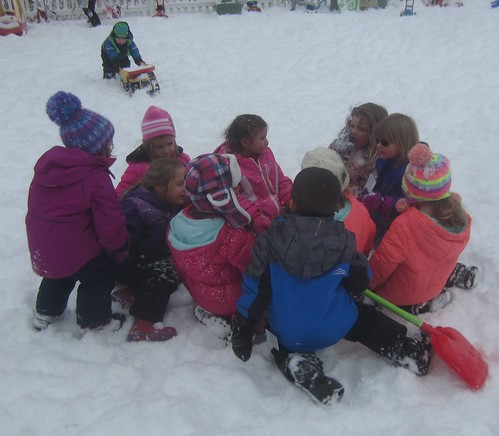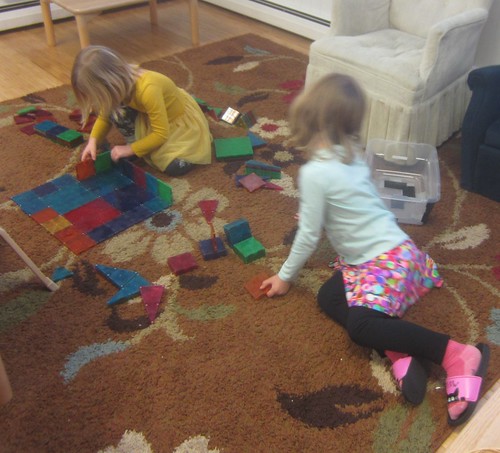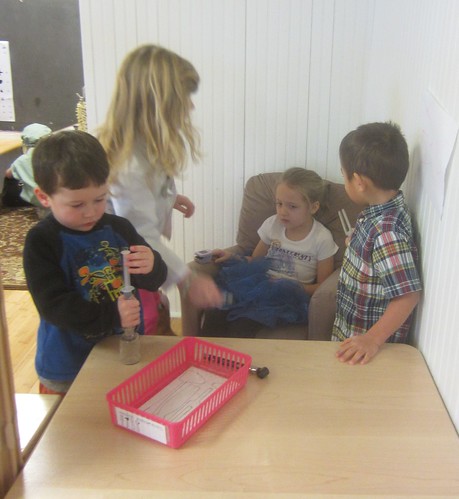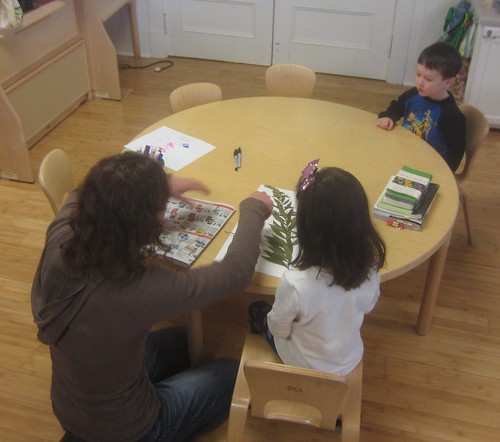2020 started with some wonderfully snowy days. We did lots of shoveling! We shoveled pathways, shoveled scoops of snow to dump on our heads, shoveled snow into trucks, shoveled snow into buckets, shoveled snow off the tunnel and toys, and shoveled snow into a giant hill for sledding.
Cold temperatures kept us in on Thursday, so we did some indoor activities. We set up a small obstacle course, which challenged our balance, coordination, strength, and control. Some children put on puppet shows, others built with magnatiles, and some constructed with bristle blocks.
Monday students were introduced to blow painting. They dropped little drips of liquid watercolor onto their papers, then used a straw to blow the paint all around in different shapes and patterns. Some children made small detailed paintings, and some continued to try lots of different colors and blowing strategies until their papers were covered. They helped introduce blow painting to the rest of the class on Tuesday, and everyone who wanted had an opportunity to create their own works of art.
We began to introduce seeing mistakes as opportunities to learn, and struggles as opportunities to grow. We discussed taking on challenges and persevering even when things are hard. Some of the students shared some really helpful advice about trying again and again, even if you can’t do it the first, second, or third time. We read some stories about mistakes and challenges, including The Day Roy Rigels Ran the Wrong Way and Cowardly Clyde.
During sign language we reviewed all the signs we learned last year, then learned numbers 6-10. Because the numbers are made with one hand, rather than counting fingers with two, we were really working our fine motor (finger) skills trying to touch the correct fingers together!
As our study of the universe progresses to the planets, we decided to make our dramatic play area into a physician’s office where astronauts would be examined and checked to make sure they are healthy enough to go into space, as astronauts must be very healthy! The children helped brainstorm what should be included in our health center, who would work there and who would visit, and they helped to set things up for play. The various medical instruments and roles were introduced and discussed before beginning play. Once things were underway, there were a lot of busy nurses and doctors, and some patients receiving some thorough medical exams.
On Thursday Rachel Cliche returned to work with the students in preserving the plants they collected and pressed in the fall. Each student very carefully glued their plant to a special piece of paper, then found it in a plant identification guide, wrote the information on their paper, and set them to dry.
We introduced a few new songs about elephants this week, which the children had a lot of fun with. They pretended to be elephants playing on a spiders web, holding the tails of the elephants in front of them with their trunks. We also sang “Willoughby Wallaby Woo, An Elephant Sat on You,” changing woo to w words rhyming with names, who the elephant would then sit on. They thought it all quite funny!
We have been doing some rhythm work. We started by reading some rhymic books, including Tanka, Tanka, Skunk and Crocodile Beat. We clapped people’s names and clapped along with Tanka, Tanka, Skunk. Susan did some clapping rhythms with us, which we would imitate, then we used claves (rhythm sticks) to clack out patterns. She read Chicka, Chicka, Boom, Boom and we followed the pattern every time it said “Chicka, chicka, Boom, boom, will there be enough room?” We will continue practice with rhythm making, imitating and creating increasingly challenging rhythms.
Friday students have moved on to a study of the human body as we begin to learn about being healthy in conjunction with our dramatic play medical office. We began by introducing the senses, and the first sense we explored was sight. The children talked about things that they can learn about by looking at them, and we read some stories about the senses, sight, and how eyes work. We examined a model of an eyeball and found some of the parts, including the cornea, lens, pupil, iris, retina, muscles, and optic nerve. We then played “I spy,” taking turns giving clues about different things we could see in the classroom.































































